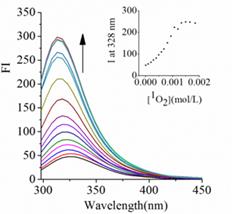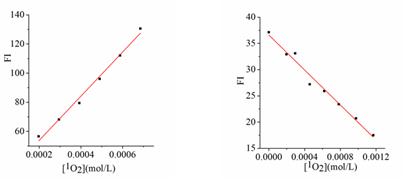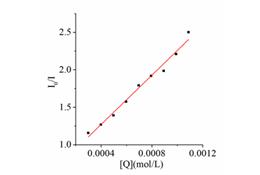Zhang Jundi, Wang Xiaoyu, Zhang Jintao, Li Anwen, Yang Yanqiu, Liu Yanju
Henan University of Chinese Medicine, Zhengzhou Henan China 450046
ABSTRACT:Paeoniflorin has been studied as singlet oxygen probe by fluorescence spectroscopy, the results indicated that paeoniflorin acted as a highly sensitive and selective fluorescent probe for singlet oxygen in aqueous, resulting in 6.25 -fold enhancement in neutral medium, and 9.95-fold decrease in alkaline medium, the detection limit is 2.6 and 38.7μM respectively, and the rate constant of the neutral condition was 1.3 1011 mol·L-1·s-1, results indicate that paeoniflorin holding great potential to be used as a probe for singlet oxygen in cells with high sensitivity and selectivity.
1011 mol·L-1·s-1, results indicate that paeoniflorin holding great potential to be used as a probe for singlet oxygen in cells with high sensitivity and selectivity.
KEYWORDS: singlet oxygen; fluorescent probe; paeoniflorin
Creatures produce a lot of reactive oxygen species (ROS) in the metabolic process, and many diseases, deterioration, organism aging and many normal physiological processes are closely related to these free radicals, Singlet oxygen (1O2) is one of the most important [1]. Singlet oxygen, also known as the active oxygen species that are excited by the ground state oxygen molecules to the first excited state [2]. Singlet oxygen in the body involved in a variety of physiological activities, and in the signal transduction, nerve transmission, muscle tension regulation, peristalsis and platelet healing and so have a very important role [3-5]. But because 1O2 is a strong electrophilic reagent and it can react with some biological molecules such as amino acids, proteins, enzymes and nucleic acids leading to the body's injury [6] that lead to cell necrosis and cause serious chronic diseases [7]. Therefore, it is very important to establish a scientific and reasonable singlet oxygen detection method to study the mechanism of singlet oxygen, reveal the pathogenesis of biological cell oxidation, aging, cancer and other diseases, and further research the effective ways of aging and cancer treatment.
Detecting singlet oxygen usually includes direct and indirect methods. Direct method is to detect 1269 nm singnaluse near-infrared photodetector [8]. For the past few years, the indirect method used widely, such as spectrophotometry [9], High Performance Liquid Chromatography (HPLC) [10], fluorescence spectrophotometry [2], chemiluminescence [11] and electron spin resonance(ESR) [12]. The principle of spectrophotometry and fluorescence spectroscopy are to detect the absorbance or fluorescence intensity of the probe changing with the singlet oxygen [13,14]. Quantitative analysis of reactive oxygen species indirectly by measuring the change of fluorescence intensity [15]. Fluorescence probe is very promising to reveal the biological function of molecules. Researchers can use the probe to obtain the spatial information of the target molecule in the organic cell system and obtain relevant information about the required reactive oxygen species in a short time.
Paeoniflorin is an active ingredient of white peony root and belongs to monoterpenoidglucoside compound. In recent years, paeoniflorinwas studied widely. It was found that paeoniflorinhas the effect of anti-free radical damage and anti-oxidation. In this paper, the sensitivity, selectivity and reaction rate of paeoniflorin with singlet oxygen were studied.
1 Apparatus and Reagents
1.1 Apparatus
224S-CW electronic Balance (Sartorius Scientific Instrument Co., Ltd. China), PHS-3C pH meter (Shanghai REX Instrument Corp. , China), UV-2600 UV-Vis Spectrometer (Techcomp, China), F-7000 Fluorescence Spectrophotometer (Hitachi, Japan).
1.2 Reagents
Sodium hypochlorite, 30% hydrogen peroxide, 96% sulfuric acid, Disodium phosphate, Potassium dihydrogen phosphate, sodium bicarbonate, sodium carbonate, sodium molybdate, ammonium ferrous sulfate, sodium nitrite, sodium hydroxide, manganese dioxide, All the above chemicals were analytical-reagent grade. Paeoniflorin(Chinese identification of pharmaceutical and biological products, Reference standards, 99.2%). All solutions were prepared with double-distilled water.
2 Methods
All fuorescence measurements were carried out on a Hitachi F-7000 luminescence spectrometer equipped with a 1 cm quartz cell.
3 Results and discussion
3.1 Detection of 1O2 with Paeoniflorin as a probe in aqueous buffer
Fluorescence spectroscopy has the advantages of strong selectivity, short detection time, less interference, accurate results, less sample and simply method, provide more physical parameters, practicality [16], highly sensitivity, lower detection limit. Which can provide many parameters including excitation spectrum, emission spectrum and fluorescence intensity. Quantitative analysis can be done by measuring these parameters [17]. Fluorescence spectroscopy has a wide range of applications in life sciences, environmental sciences, materials science, food science, public security, intelligence, industrial and agricultural production [18]. Therefore, studied the change of fluorescence spectrum between singlet oxygen probe and singlet oxygen is an important method to study the performance of singlet oxygen probe. The fluorescence spectra of paeoniflorin with singlet oxygen in neutral and alkaline buffer solutions were shown in Fig. 1 and Fig. 2.
| 
|

|
| Fig.1 Changes in the emission spectra of paeoniflorin upon addition of 1O2 in neutral buffer solution (pH 7.10 ). Inset: Plots of emission intensity at 328 nm vs. concentrations of 1O2. |
Fig. 2 Changes in the emission spectra of paeoniflorin upon addition of 1O2 in alkaline buffer solution (pH 10.05 ). Inset: Plots of emission intensity at 328 nm vs. concentrations of 1O2. |
Fig. 1 and Fig. 2 are the fluorescence spectra of paeoniflorin in neutral and alkaline buffer solutions with singlet oxygen. It can be seen from the figure that in neutral buffer solution, the fluorescence intensity at 328 nm gradually increased and blue shift as the singlet oxygen concentration increased, with ON/OFF of 6.25. However, in the alkaline buffer solution, the fluorescence intensity at 328 nm decreased gradually with the increase of the singlet oxygen concentration, its ON/OFF is 9.95. In the neutral and alkaline buffer solution, the concentration of singlet oxygen increase can cause the change of the fluorescence intensity of paeoniflorin. This indicates that paeoniflorin can be used as a fluorescent probe for singlet oxygen.
The linear detection range of paeoniflorin to singlet oxygen in the 50 mmol/L phosphate buffer solution at pH = 7.10 was 2×10-4 ~ 7×10-4mol/L. R2 is 0.98794. The linear detection range of paeoniflorin to singlet oxygen in the 50 mmo/L carbonate buffer solution at pH = 10.05 was 0~1.2×10-3mol/L. R2 is 0.97801. These indicate that the paeoniflorin can detect singlet oxygen quantitatively in neutral and alkaline solution. The results are shown in Fig. 3 and Fig. 4.
| |

|
| Fig. 3 The linearity of paeoniflorin detection for singlet oxygen in neutral buffer solution (pH 7.10 ) |
Fig. 4 The linearity of paeoniflorin detection for singlet oxygen in alkaline buffer solution (pH 10.05 ). |
3.2 Selectivity of paeoniflorin to oxygen species
The results of paeoniflorin with H2O2, •OH, ONOO-, 1O2 [19,20]under neutral conditions are shown in Fig. 5. The fluorescence intensity of the paeoniflorin increase remarkably upon reaction with 1O2, whereas it is little affected by addition of H2O2, ·OH, and ONOO– in neutral media. Thus, we can conclude that the paeoniflorin is a specific fluorescence probe for 1O2 in neutral media.
| 
|
| Fig. 5 Fluorescence intensity of paeoniflorin interacted with H2O2, ·OH, ONOO-, 1O2 in neutral condition |
3.3 The detection limit
The values of the 1O2 detection limit (DL) of paeoniflorin in the neutral and alkaline media, calculated as the concentrations corresponding to three-fold standard deviations of the background signal, are 2.6 µmol/L and 38.7 µmol/L, respectively [21].
3.4 Determination of rate constant of paeoniflorin and singlet oxygen
Singlet oxygen is a very unstable active oxygen molecule. It can not only react with the molecules in the environment, but can be quenching very fast by itself. Thus, a good singlet oxygen fluorescence probe should have a very high reaction rate with singlet oxygen. Thus the probe can react quickly with the singlet oxygen, minimize the singlet oxygen itself quenching error, and improve the determination of the sensitivity and accuracy [22,23]. Fig. 6 shows the linear relationship between the fluorescence intensity and histidine concentration at 328 nm in 50 mmol/L phosphate buffer solution of paeoniflorin at pH = 7.10. The reaction rate constant of paeoniflorin with singlet oxygen was calculated to be 1.3 1011 mol·L-1·s-1[24-26]. The results showed that paeoniflorin had a great reaction rate with singlet oxygen. Therefore, paeoniflorin has a potential use in the biological system to detect singlet oxygen.
1011 mol·L-1·s-1[24-26]. The results showed that paeoniflorin had a great reaction rate with singlet oxygen. Therefore, paeoniflorin has a potential use in the biological system to detect singlet oxygen.
| 
|
| Fig.6 Linear relationship between fluorescence intensity and histidine concentration of paeoniflorin in neutral buffer solution (pH= 7.10 ). |
4 Conclusion
Paeoniflorin can specifically and rapidly react with 1O2, resulting in remarkable changes in emission spectrum in both neutral and alkaline buffers. The detection of 1O2 by monitoring the linear dependence of the emission intensities on 1O2 concentrations in the neutral and the alkaline buffers was found to be very sensitive with very low detection limits of 2.6 and 38.7μM respectively. Moreover, paeoniflorin exhibited high selectivity to 1O2 as compared to its responses to the other reactive oxygen species of 1O2, •OH, H2O2, and ONOO−. However, the paeoniflorin has advantage of high water solubility, lower toxic and side effect, The above-mentioned characteristics make paeoniflorin promising for practical application as fluorescence singlet oxygen sensors in biological systems.
REFERENCES
1 Wang L. Physiological function and detection technology of singlet oxygen. Science & Technology Information.2010;17:912.
2 Lv Q., Zhang M., Yue N.,et al. Applications and progresses indetermination of singlet oxygen.Chemical Analysis.2008;74-76.
3 Carlos D. C., Juliana C. A., Silvia M.S.,et al. Effect of flavonoids on 20-deoxyguanosine and DNA oxidation caused by singlet molecular oxygen. Food and Chemical Toxicology.2010;48:2380-2387.
4 Sayuri M., Glaucia R. M., Marisa H. G.M., et al. Singlet molecular oxygen generated from lipid hydroperoxides by the Russell mechanism studies using 180-labeled linoleic acid hydroperoxide and monomol light emission measurements. Journal of the American Chemical Society.2003;125:6172-6179.
5 Barry H., John M. C. G..Free radicals in biology and medicine. Clarendon:Oxford Science Publications,2007.
6 Liao B., Wu Y., Peng C.,et al. Study on the inhibition of single - phase oxygen damage to certain substances by DNA.Guangxi Chemical Industry.1989;4:60.
7 Fu Y., Hou S., Huang X., et al. A biological method for the evaluation of the singlet oxygen (1O2) scavenging capacities of antioxidants. Journal of Yunnan Nationalities University Natural Science Edition.2016;25(2) :114-120.
8 Kanofsky J. R.. Singlet oxygen production from the peroxidase-catalyzed oxidation of indole-3-acetic acid. The Journal of Biological Chemistry.1988; 28:14171-14175.
9 Li J., Jia B., Zhai Q., et al. Progress in spectrophotometric determination of aluminium. Rock and Mineral Analysis.2006:64-66.
10 Guan J., He C., Ren L., et al.Application progress of chromatography in the separation and determination of rare earth elements. Rock and Mineral Analysis. 2012;5:768-770.
11 Li J.. Application of chemiluminescence in pharmaceutical and biological analysis. Nanchang: Nanchang University, 2011.
12 Wang C. , Ye L., Xie A., et al.Progress and applications of electron paramagnetic resonance spectroscopy.Laboratory Research and Exploration.2013;5:5-67, 25.
13 Yin H., Qian Q., Zhang X. Recent progress in detection of singlet oxygen by fluorescent probes containing anthracene ring. Journal of Qujing Normal University.2016; 35(30):27-34.
14 Wang L.. Physiological function and detection technology of singlet oxygen.
Science & Technology Information. 2010;17:912.
15 Xu S.. Research progress of fluorescent probe for detecting reactive oxygen species. Journal of Wuhan University of Science and Engineering. 2008; 12: 12-21.
16 Zhu C., Xie X., Zhao J., et al. The study of three-dimensional synchronous fluorescence spectral characteristics of Liu Wei Di Huang Pills. Spectroscopy and Spectral Analysis.2017;1:141-145.
17 Yin Y., Xiang B., Tong L.. The application of studying fluorescence spectroscopy on protein.Experimental Technology and Management. 2010;2:33-40.
18 Hudnall T. W., Melaïmi M., Gabbaï F. P..Hybridlewis acid/hydrogen-bond donor receptor for fluoride.Organic Letters.2006; 8:2747-2749.
19 Liu B., Tian H.. A ratiometric fluorescent chemosensor for fluoride ions based on a proton transfer signaling mechanism. Journal of Materias Chemistry.2005;15:2681-2686.
20 Chen Y., Wang Z., Wang H., et al. Singlet oxygen-engaged selective photo-oxidation over Pt Nanocrystals/Porphyrinic MOF:The roles of photothermal effect and Pt Electronic state. Journal of the American Chemical Society.2017;139(5):2035–2044.
21 Martinez M., SancenonR..Fluorogenic and choromogenicchemosensors and reagents for anions.Chemical Reviews.2003;103:4419-4476.
22 Song B.. Novel Lanthanide fluorescence probes and their application to Time-Resolved Fluorescence detection of singlet oxygen. Dalian: Dalian Institute of Chemical Physics Chinese Academy of Sciences. 2006: 25-63.
23 Liu Y.. Singlet oxygen luminescent probes based on transition metal complexes. Beijing:Beijing Normal University. 2009:56-63.
24 Kim S. K., Yoon J..A new fluorescent PET chemosensor for fluoride ions.Chemical Communications.2002;7:770-771.
25 Cho E.J., Moon J.W., Ko S.W.,et al.A new fluoride selective fluorescent as well as
chromogenic chemosensor containing a naphthalene urea derivative. Journal of the American Chemical Society. 2003;125:12376-12377.
26 Lee J., Jin C., Mukamel S.,et al.Efficient fluoride-selective flouresce host experiment and theory.The Journal of Organic Chemistry.2004; 69:943-950.
Received 20 November 2017;accepted 5 December 2017
Correspondence: Liu Yanju, PhD;E-mail:liuyanju886@163.com
Editor: Qin Lin

